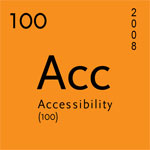10 Tips for Communicating with People with Disabilities

Communication is the basis for all interaction between humans. When a disability is involved, the interaction is often hesitant, uncertain or even, unfortunately, avoided. Communicating with people with disabilities can be improved with these tips:
- When talking with a person with a disability, speak directly to the person rather than through a companion or sign language interpreter.
I really dislike when someone turns to my husband for a response after asking me a question. Or, when a restaurant server asks, “What does she want?”
- When introduced to a person with a disability, offering to shake hands is appropriate. People with limited hand use or who wear an artificial limb can usually shake hands. (Shaking hands with the left hand is an acceptable greeting.)
- When meeting a person who is sight impaired, always identify yourself and others who may be with you. When talking in a group, remember to identify the person to whom you are speaking.
- If you offer assistance, wait until the offer is accepted. Then listen to or ask for instructions.
I find it annoying when someone asks if I need help and then rushes in to help after I have kindly said no. Sometimes assistance is appreciated; other times I tolerate it as my good deed for the day so that someone else feels helpful.
- Treat adults as adults. Address people who have disabilities by their first names only when extending the same familiarity to all others. (Never patronize people who use wheelchairs by patting them on the head or shoulder.)
- Respect an individual’s personal space. Leaning on or hanging on to a person’s wheelchair or mobility device is similar to leaning or hanging on to a person and is generally considered annoying or, sometimes, even rude.
If, however, you need to steady yourself for a moment, simply ask first.
- Listen attentively when you’re talking with a person who has difficulty speaking. Be patient and wait for the person to finish, rather than correcting or speaking for the person. If necessary, ask short questions that require short answers, a nod or shake of the head. Alternatively, enable the individual to write or type or use a communication device to communicate the message.
Never pretend to understand if you are having difficulty doing so. Instead, repeat what you have understood and allow the person to respond. The response will clue you in and guide your understanding.
- When speaking with a person who uses a wheelchair or crutches or a person of short stature, place yourself at eye level by squatting down, leaning against a counter or taking a seat to facilitate the conversation, particularly if it may be a long one. This relieves the neck strain and the power imbalance perceived when someone is towering over another.
Remember: My eye level is your fly level! - To get the attention of a person who is Deaf or hard of hearing, tap the person on the shoulder or wave your hand. Look directly at the person and speak clearly and expressively to determine if the person can read your lips. If you are a fast talker, slow down your speech slightly to make it easier to understand.
Not all people who are Deaf can read lips. For those who do lip read, be sensitive to their needs by placing yourself so that you face the light source and keep hands, cigarettes and food away from your mouth when speaking. Pen and paper can also facilitate communication.
The easiest way to ask if a person wants to communicate by lip reading is to point to your lips with a questioning look, or by writing is to make the motion of writing in your palm with a questioning look.
- Relax. Don’t be embarrassed if you happen to use accepted, common expressions such as “See you later,” or “Did you hear about that?” that seems to relate to a person’s disability. Don’t be afraid to ask questions when you’re unsure of what to do.
Accessibility 100 is a series of 100 easy-to-implement, free and inexpensive tips for improving accessibility for people with disabilities. This is a community project. Feel free to leave your comments, questions and ideas for future Accessibility 100 posts.
Get the entire series by subscribing to this blog by filling in the form in the upper right corner or by subscribing to the RSS feed.
If you enjoyed this post, consider buying me a chai tea latte. Thanks kindly.
 Subscribe via RSS
Subscribe via RSS



